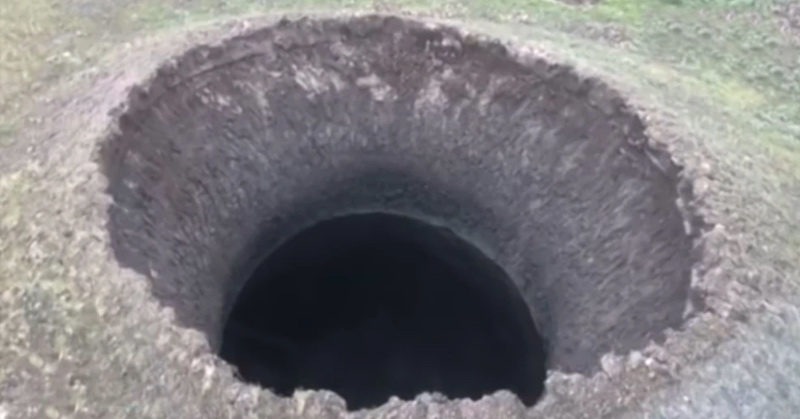A 50 meters-deep arctic crater has suddenly opened up in the Arctic tundra. The potential cause behind it is both mysterious and fascinating.
A Sudden, Massive Arctic Crater
Since 2014, scientists have been discovering craters in the Arctic tundra. The most recent of these is an arctic crater reported by Siberian media that has suddenly appeared and is a whopping 50 meters deep. It was discovered by a TV crew from station Vesti Yamal who was on the tundra for an assignment. (1)
Scientists have been researching craters like this that have been appearing on the Yamal and Taymyr tundra for years. They believe that they may be the result of something called cryogenic eruptions, also known as ice volcanoes. (1)
What Are Cryogenic Eruptions?
Previously observed on other planets but thought to not exist here on Earth, cryogenic eruptions, or cryovolcanoes (aka ice volcanoes), are really quite similar to the regular lava-filled volcanoes we are used to hearing about. (1) Typically, these volcanoes (2):
- Rise up from the earth
- Spew out liquid contents when active
What sets cryovolcanoes apart from the others is that instead of magma or molten rock, the volcano contains different ingredients. (2) These include (2):
- Water
- Ammonia
- Methane compounds
- Chlorine compounds
The “rock” that builds up the volcano itself is the solid ice equivalents of all of those liquids. The “magma” or mixture of those liquids gather beneath the surface and rise up as they get warmer and less dense than the outside of the volcano. (2)
As the magma rises, it contains bubbles of gas, chunks of ice or rock, and crystals. In an effort to restore the balance between the outside and inside temperatures, the volcano will blow either through and already open top or it will force its way out of the earth’s surface, causing an earthquake or giant crater to open up. (2)
When those craters are dormant or extinct, they eventually fill up with water and become another one of the many lakes found around the tundra’s surface. (2)
Is This Arctic Crater an Ice Volcano?
Though ice volcanoes have been recorded and studied on other planets, they have not been on earth until now. Though they aren’t sure yet if a cryogenic eruption is the cause of this arctic crater, Lomonosov Moscow State University geologist Andrey Bychkov says this would provide an ample explanation. (1)
Other Explanations
A cryogenic eruption is not the only potential cause of an arctic crater like this one. Meteorite impact or deep migration of gas under the earth’s surface also could cause one to suddenly open up. (1)
In the past, it has been thought that these arctic craters are formed when an ice-cored hill called a pingo explodes. (1) There are a few steps that cause this to occur (1):
- An area of unfrozen ground surrounded by permafrost called a talik, forms underneath a thaw lake. This takes thousands of years.
- The surface of the talik freezes while methane and carbon dioxide build-up in the core.
- This causes a huge amount of pressure to press up on the frozen talik, which eventually bursts and creates a crater.
These craters eventually fill up with water and become lakes. (1)
The exploding pingos are usually associated with a warmer-than-usual summer, though any connection such as this to a cryovolcano is still unknown. (1)
An Unexplored World
The more pertinent part of studying an arctic crater isn’t as much about whether or not it is an ice volcano, but rather at the various life forms and organisms that live inside them.
“It is a closed world with evolution separated from oxygen for thousands of years. Special microbes can live at low temperatures and produce gases, which provide cryovolcanism. This world has not been explored.” Bychkov explains. (1)
Studying organisms such as those can help us better understand the arctic world and hopefully find more clues as to how we can protect it.
Keep Reading: Dozens of Previously Unknown Viruses Discovered in 15,000-year-old Glaciers

